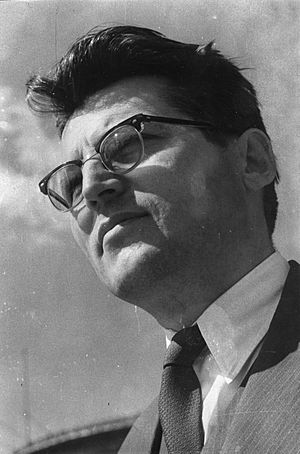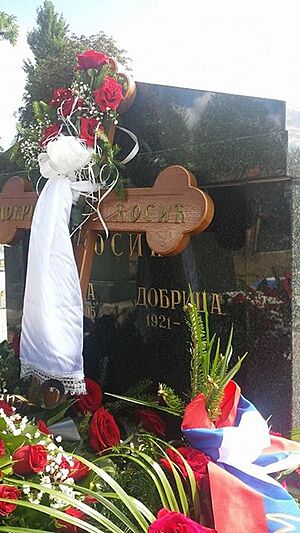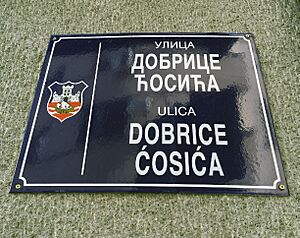Dobrica Ćosić facts for kids
Quick facts for kids
Dobrica Ćosić
|
|
|---|---|

Ćosić in 1961
|
|
| 1st President of the Federal Republic of Yugoslavia | |
| In office 15 June 1992 – 1 June 1994 |
|
| Prime Minister | Aleksandar Mitrović (acting) Milan Panić Radoje Kontić |
| Preceded by | Position established |
| Succeeded by | Zoran Lilić |
| 15th Chairperson of the Non-Aligned Movement | |
| In office 15 June 1992 – 7 September 1992 |
|
| Preceded by | Branko Kostić |
| Succeeded by | Suharto |
| Personal details | |
| Born |
Dobrosav Ćosić
29 December 1921 Velika Drenova, Kingdom of Serbs, Croats and Slovenes |
| Died | 18 May 2014 (aged 92) Belgrade, Serbia |
| Resting place | Belgrade New Cemetery |
| Nationality | Serbian |
| Political party | SKJ (until 1968) |
| Awards | Order of Bravery Order of Merits for the People Order of Brotherhood and Unity NIN Award (1954, 1961) Pushkin Medal (2010) |
Dobrica Ćosić (born Dobrosav Ćosić; 29 December 1921 – 18 May 2014) was an important writer, thinker, and politician from Yugoslavia and Serbia. He was known for his books and his role in shaping modern Serbian politics.
Ćosić received the famous NIN award for literature twice. He also won the Medal of Pushkin for his writing. His books have been translated into 30 different languages, showing how widely read and respected he was.
He served as the first President of the Federal Republic of Yugoslavia from 1992 to 1994. Some people called him the "Father of the Nation" because of his big influence on Serbian politics. Others used this name in a joking way.
Contents
Early Life and Career
Dobrica Ćosić was born on 29 December 1921 in a Serbian village called Velika Drenova. His parents were Žika and Milka.
Before World War II, he went to an agriculture school. In 1939, he joined a youth group linked to the communist movement. When World War II reached Yugoslavia in 1941, he joined the Partisans. These were groups fighting against the occupation.
After the war, he continued to be active in communist leadership. He worked in propaganda and became a people's representative. In the early 1950s, he visited the Goli otok prison. This prison held people who disagreed with the Communist Party. Ćosić said he went there to understand the system better.
Ćosić wrote his first novel, Daleko je sunce (The Sun is Far Away), in 1951. This book was very popular and helped him start a successful writing career. Through his books, he could share his ideas about revolution. Around this time, he stopped working full-time for the Communist Party.
In 1956, he was in Budapest when the Hungarian revolt began. He was there for a meeting of literary magazine editors. He even gave speeches supporting the revolution. When he returned to Belgrade, he wrote a detailed report about what he saw. This report influenced Yugoslavia's official view on the situation. Parts of his experiences were later published as Seven Days in Budapest.
Later in 1956, Ćosić was chosen to help create a new plan for the Communist Party. He claimed he wrote parts of this plan himself. He was concerned that the plan didn't focus enough on culture. He wanted culture to have a bigger role in socialism.
Political Views and Opposition
Until the early 1960s, Ćosić strongly supported Marshal Tito and his idea of a united Yugoslavia. In 1961, he even went on a long trip with Tito on the presidential yacht, the Galeb. They visited several non-aligned countries in Africa. This trip showed his close relationship with the government at the time.
Between 1961 and 1962, Ćosić had a public debate with a Slovenian thinker, Dušan Pirjevec. They argued about how much power local regions (autonomy) should have versus the central government (centralism) in Yugoslavia. Ćosić believed the central government should be stronger. He worried about different groups within Yugoslavia becoming too separate. Even though Tito supported Ćosić's ideas, the country actually moved towards more local power.
As Yugoslavia's government gave more power to local regions after 1963, Ćosić became worried about the Serbian people. In 1968, he gave a famous speech where he criticized the government's policy on different nationalities. He was especially concerned about more power being given to Kosovo and Vojvodina. After this, he became known as a "dissident," someone who openly disagrees with the government.
In the 1980s, after Tito died, Ćosić helped lead a movement. It started by wanting equal rights for Serbia within Yugoslavia. But it quickly became more intense. He strongly supported the rights of Serbs and Montenegrins in Kosovo.
Ćosić was a member of the Serbian Academy of Sciences and Arts. Many people thought he was its most important member. He was sometimes linked to a document called the Memorandum of the Serbian Academy of Sciences and Arts. However, he did not actually write it. In 1989, he supported Slobodan Milošević as a leader. Two years later, he helped Radovan Karadžić become a leader of the Bosnian Serbs. When war started in 1991, he supported the Serbian side.
President of FR Yugoslavia

In 1992, Dobrica Ćosić became the president of the Federal Republic of Yugoslavia. This new country included Serbia and Montenegro. In January 1993, he spoke on Serbian television. He warned that Western countries were demanding "national surrender." He said that if they didn't agree, they would face attacks from powerful armies. He believed these outside forces wanted to make the Serbian people follow "Muslim rule."
His support was important for the rise of Serbian nationalist leader Slobodan Milošević. Some people who disagreed with Ćosić saw him as a key person behind the idea of a "Greater Serbia." This was a plan by some Serbian nationalists to unite Serbia with areas where Serbs lived in Croatia and Bosnia. Later, Ćosić disagreed with Milošević and was removed from his position.
In 2000, Ćosić joined Otpor!, a group that was against Milošević.
Personal Life
In 1947, Dobrica Ćosić married Božica Djulaković. They had a daughter named Dr Ana Ćosić Vukić.
Death and Legacy
Dobrica Ćosić passed away on 18 May 2014 in his home in Belgrade. He was 92 years old. He was buried next to his wife in a family plot at the Belgrade New Cemetery on 20 May 2014.
In March 2019, a street in Belgrade was named after him to honor his memory.
Literary Works
- Dаleko je sunce (1951)
- Koreni (1954)
- Deobe I-III (1961)
- Akcija (1964)
- Bаjkа (1965)
- Odgovornosti (1966)
- Moć i strepnje (1971)
- Vreme smrti I-IV (1972–1979)
- Stvarno i moguće (1982)
- Vreme zlа: Grešnik (1985)
- Vreme zlа: Otpаdnik (1986)
- Vreme zlа: Vernik (1990)
- Promene (1992)
- Vreme vlаsti 1 (1996)
- Piščevi zаpisi 1951—1968 (2000)
- Piščevi zаpisi 1969—1980 (2001)
- Piščevi zаpisi 1981—1991 (2002)
- Piščevi zаpisi 1992—1993 (2004)
- Srpsko pitаnje I (2002)
- Pisci mogа vekа (2002)
- Srpsko pitanje II (2003)
- Kosovo (2004)
- Prijаtelji (2005)
- Vreme vlаsti 2 (2007)
- Piščevi zаpisi 1993—1999 (2008)
- Piščevi zаpisi 1999—2000: Vreme zmijа (2009)
- Srpsko pitanje u XX veku (2009)
- U tuđem veku (2011)
- Bosanski rat (2012)
- Kosovo 1966-2013 (2013)
- U tuđem veku 2 (2015)
See also
 In Spanish: Dobrica Ćosić para niños
In Spanish: Dobrica Ćosić para niños



